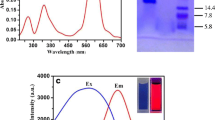Abstract
Phycocyanin is a natural brilliant blue colored, fluorescent protein, which is commonly present in cyanobacteria. In this study, C-phycocyanin was extracted and purified from Spirulina platensis, which are multicellular and filamentous cyanobacteria of greater importance because of its various biological and pharmacological potential. It was analyzed for its binding affinity towards blood cells, algal cells, genomic DNA of microalgae, and bacteria at different temperature and incubation time. It showed good binding affinity with these components even at low concentration of 2.5 μM. The purpose of this study was to evaluate the applicability of C-phycocyanin as a green fluorescent dye substituting carcinogenic chemical dyes.






Similar content being viewed by others
References
Adir N, Dobrovetsky E, Lerner N (2001) Structure of C-phycocyanin from the thermophilic cyanobacterium Synechococcus vulcanus at 2.5 W: structural implications for thermal stability in phycobilisomes assembly. J Mol Biol 313:71–81
Arad S, Yaron A (1992) Natural pigment from red micro algae for use in food and cosmetics. Trends Food Sci Technol 3:92–97
Chakdar H, Jadhav SD, Dhar DW, Pabbi S (2012) Potential application of blue green algae. J Sci Ind Res 71:13–20
Eriksen NT (2008) Production of phycocyanin—a pigment with applications in biology, biotechnology, foods and medicine. Appl Microbiol Biotechnol 6-11
Izydorczyk K, Tarczynska M, Jurczak T, Mrowczynski J, Zalewski M (2005) Measurement of phycocyanin fluorescence as an online early warning system for cyanobacteria in reservoir intake water. Environ Toxicol 20:425–430
Jelly R, Patton EL, Lennard C, Lewis SW, Lim KF (2009) The detection of latent finger marks on porous surfaces using amino acid sensitive reagents: a review. Anal Chim Acta 652(1):128–142
Kuddus M, Ramteke PW (2009) Binding affinity of allophycocyanin to blood cells and nuclei. Sci Res Essays 4:1132–1135
Mishra S (2007) Phycobiliproteins from microalgae. In: Tewari A (ed) Recent advances on applied aspects of Indian marine algae with reference to global scenario, Vol 2. CSMCRI, Bhavnagar, pp. 273–284
Mishra SK, Shrivastava A, Mishra S (2008) Effect of preservatives for food grade C-PC from Spirulina platensis. Process Biochem 43:339–345
Mishra S,(2006) unpublished data DAAD
Munier M, Jubeau S, Wijaya A, Morançais M, Dumay J, Marchal L, Fleurence J (2014) Physicochemical factors affecting the stability of two pigments: R-phycoerythrin of Grateloupia turuturu and B-phycoerythrin of Porphyridium cruentum. Food Chem 150:400–407
Patel A, Mishra S, Pawar R, Ghosh PK (2005) Purification and characterization of C-phycocyanin from cyanobacterial species of marine and freshwater habitat. Protein Expres Purif 40:248–255
Patel A (2004) Investigation on physico-chemical properties of phycobiliproteins (pb) from cyanobacterial species of Indian coast (doctoral thesis). Bhavnagar University, Bhavnagar, Gujarat
Schmid I, Cole SW, Jack JW, Giorgi JV (2000) Measurement of lymphocyte subset proliferation by three-color immune-fluorescence and DNA flow cytometry. J Immunol Methods 235:121–131
Sekar S, Chandramohan M (2007) Phycobiliproteins as a commodity: trends in applied research, patents and commercialization. J Appl Phycol 20:113–136
Singh P, Kuddus M, Thomas G (2011) Isolation and binding affinity of C-phycocyanin to blood cells and genomic DNA as well as its diagnostic applications, E3. J Biotec Pharma Res 2:80–85
Spolaore P, Joannis-Cassan C, Duran E, Isambert A (2006) Commercial applications of microalgae. J Biosci Bioeng 101:87–96
Thajuddin N, Subramanian G (2005) Cyanobacterial biodiversity and potential applications in biotechnology. Curr Sci 89:47–57
Thangam R, Suresh V, Princy WA, Rajkumar M, Senthil Kumar N, Gunasekaran P, Rengasamy R, Anbazhagan C, Kaveri K, Kannan S (2013) C-phycocyanin from Oscillatoria tenuis exhibited an antioxidant and in vitro anti-proliferative activity through induction of apoptosis and G0/G1 cell cycle arrest. Food Chem 140:262–272
Vrieling EG, Anderson DM (1996) Immuno-fluorescence in plankton research, application and potential. J Phycol 32:1–16
Zheng J, Inoguchi T, Sasaki S, Maeda Y, McCarty MF, Fujii M, Ikeda N, Kobayashi K, Sonoda N, Takayanagi R (2013) Phycocyanin and phycocyanobilin from Spirulina platensis protect against diabetic nephropathy by inhibiting oxidative stress. Am J Physiol Regul Integr Comp Physiol 304:110–120
Acknowledgments
We are thankful to the former Director (Dr. P. K. Ghosh), Analytical Division & Centralized Instrument Facility, Salt & Marine Chemical Division, CSIR-CSMCRI. M. Mitra and K. Bhayani would like to acknowledge CSIR and CSC-0203 for financial support and AcSIR for PhD enrolment. We would also like to acknowledge Dr. Anamika Patel, Department of Biochemistry, Emory University; Atlanta for her valuable support. This manuscript has been assigned as CSIR-CSMCRI registration no 124/2015.
Author information
Authors and Affiliations
Corresponding author
Electronic supplementary material
Below is the link to the electronic supplementary material.
Supplementary Fig. S1
(a-e) Absorption spectra of C-PC (Spirulina platensis) at different pH values and different C-PC concentrations (0.3 mg/ml, 0.2 mg/ml, 0.1 mg/ml) (JPEG 365 kb)
Supplementary Fig. S2
(a-c) Absorption spectra of C-PC (Spirulina platensis) at different ionic strength of phosphate buffer and different C-PC concentrations (0.3 mg/ml, 0.2 mg/ml, 0.1 mg/ml) (JPEG 227 kb)
Rights and permissions
About this article
Cite this article
Paswan, M.B., Chudasama, M.M., Mitra, M. et al. Fluorescence Quenching Property of C-Phycocyanin from Spirulina platensis and its Binding Efficacy with Viable Cell Components. J Fluoresc 26, 577–583 (2016). https://doi.org/10.1007/s10895-015-1742-7
Received:
Accepted:
Published:
Issue Date:
DOI: https://doi.org/10.1007/s10895-015-1742-7




